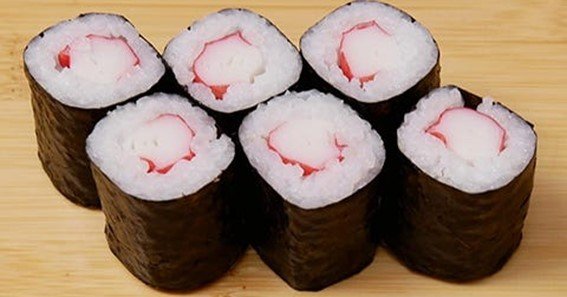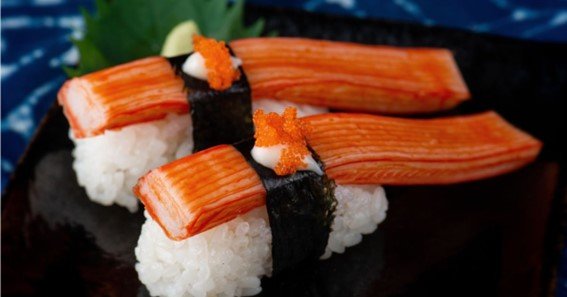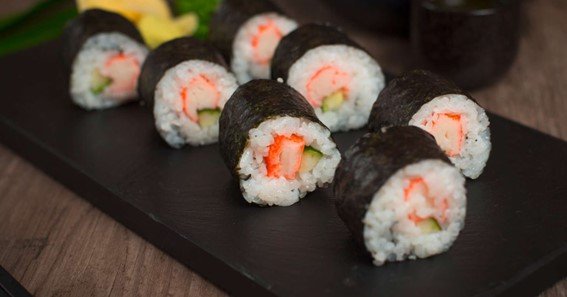What is Kani sushi? Kani sushi is a Japanese dish interesting to both experienced and new sushi eaters. Japanese terms for “kani” imply “crab,” although they usually indicate surimi, an imitation of crab meat. This article explains What is Kani sushi and what you need to know, as well as answers some frequent questions about this intriguing meal.
What Is Kani Sushi?
Kani sushi is a Japanese dish that signifies crab sushi and features crab meat as its main flavor. Many use this instead of actual crab since it’s cheaper and simpler to procure. Kani sushi is usually a hot maki roll.
Rice and seaweed are wrapped around cooked crab meat and hot mayonnaise. Kani is easy to cut or serve as crab-like sticks. Kani sushi remains popular due to its variety of flavors and textures.
What Makes Kani Sushi A Delicious And Sustainable Choice?

Japanese restaurant Kani Sushi makes tasty sushi rolls with fake crab meat. Spiced rice, nori, and spicy mayonnaise are used in this recipe to make it taste and feel like a crab. Kani sushi is a sustainable and affordable alternative to traditional seafood and showcases Japanese balance and harmony.
Making Process Of Kani Sushi
Know What is Kani sushi making process. Crushing white fish and adding starch, flavorings, and crab oils makes faux crab flesh taste better. This combination takes on the appearance and texture of crab flesh after cooking. A primary Kani sushi roll has seasoned sushi rice, nori (seaweed), and spicy mayonnaise for taste.
Before making Kani sushi, you prepare and season sushi rice with rice vinegar, sugar, and salt. Cut or shred the imitation crab meat and combine it with spicy mayonnaise and chili sauces like Sriracha. Nori and seasoned rice cover a bamboo sushi mat. After spreading crab filling on the rice, roll the mat into a cylinder. Cut the roll into tiny pieces and top with sesame seeds or tobiko (fish roe).
How Healthy Is Kani Sushi?

Like any sushi, Kani sushi is delicious if made correctly and with nutritious ingredients. It has protein but little fat or calories. Due to flavorings and additives, it has more salt and carbohydrates than actual crab flesh. Rice provides sushi’s carbohydrates, and seaweed offers vitamins and minerals like iodine.
Hot sauce on Kani sushi adds fat and calories, so be careful. A standard hot Kani maki roll offers enough protein, carbohydrates, and fat to fill you up. Reduce mayonnaise or use low-fat replacements to lose calories; to make it healthier, serve Kani sushi with fresh vegetables or a light soup.
Cultural Importance Of Kani Sushi
Japanese cuisine relies on seafood, and sushi symbolizes Japanese cuisine. Kani sushi employs artificial crab, yet it highlights how essential balance and harmony are in Japanese food, flavor, and appearance. Japanese chefs are also innovative and ingenious with surimi, which simplifies fish flavors for more people.
Changes And Service Options Of Kani Sushi
Beyond the fiery Kani maki roll, kani sushi has several variations. Kani nigiri places a faux crab on a small bed of rice and secures it with a thin nori strip. Kani fills sushi bowls (chirashi) and hand rolls (temaki). Because synthetic crab flesh is so adaptable, cooks may experiment and develop dishes for all tastes.
Popularity And Accessibility Of Kani Sushi

Kani sushi is famous internationally due to its accessibility and adaptability. Surimi-based imitation crab flesh is cheap and frequently available, making it a popular choice for sushi fans and home cooks. Easy preparation permits creative experimentation, allowing home-cooked sushi to rival restaurant excellence.
Most grocery stores provide seasoned sushi rice, nori, and spicy mayonnaise, making Kani sushi more accessible. Kani sushi’s unique flavors and textures delight and please sushi establishments and home kitchens.
Variations In Kani Sushi Preparation
Kani sushi is very flexible and can be made in many different ways to suit different tastes. In addition to the usual spicy mayonnaise, the rolls can also be made with cream cheese, avocado, or cucumber to give them more texture and flavor.
To give sushi a more gourmet look, chefs may add things like mango, tempura flakes, or eel sauce to make it more complicated. Some versions also use brown rice instead of white rice, which gives people who want a healthier choice a whole-grain option.
Conclusion
Kani sushi is good and simple to get, but it is not as popular as sushi that uses high-quality fish. Cheap fake crab meat, surimi, tastes like crab. To enjoy Kani sushi, you must know its ingredients, nutritional value, cultural importance, and serving methods. Sushi is popular worldwide because home cooks and sushi aficionados love its unique flavors and textures.
FAQ
What Is Kani Sushi Made From?
Kani sushi is made with seasoned rice, nori, and hot mayonnaise. Surimi is fake crab meat made from cooked and flavored pollock.
Is Kani Sushi Good For You?
Kani sushi is mostly healthy because it is low in fat and high in protein, but it has more salt and carbs than real crab meat.
How Do You Make Sushi From Kani?
Make seasoned sushi rice and spread it out on nori. Then, add surimi that has been mixed with spicy mayonnaise. Roll it up into a cylinder shape and cut it into pieces.
What Are Some Different Kinds Of Kani Sushi?
Adding cream cheese, avocado, cucumber, mango, or brown rice is one way to change it up. You can also make it in different bowl shapes, such as nigiri, temaki, or chirashi.
Why Do People Like Kani Sushi?
That’s right! Kani sushi is famous because it’s cheap, easy to get, and flexible, so you can make it your way and try new things at home or in a restaurant.
Can A Muslim Person Eat Sushi?
Yes, they can consume sushi.
Here are similar blogs What Is Omakase?
Sources:
https://kaesushi.com/kani-sushi/
https://www.alldayieat.com/blog/what-is-kani-in-sushi/
We have covered all the below topics in the above article
Kani sushi definition
Kani sushi explanation
Kani sushi ingredients
Kani sushi preparation










